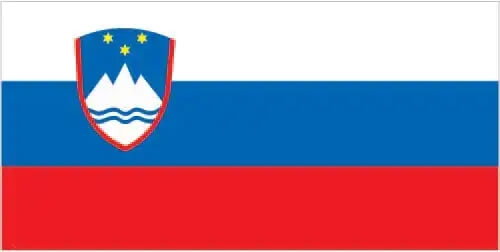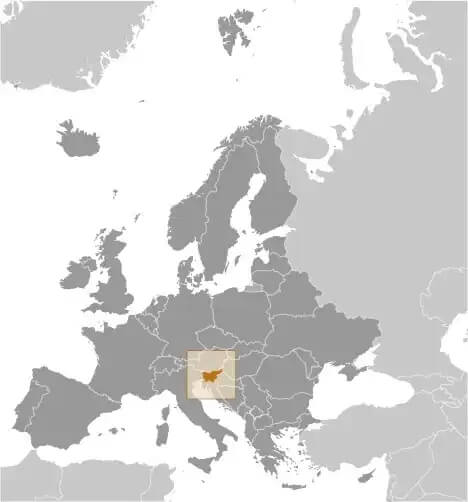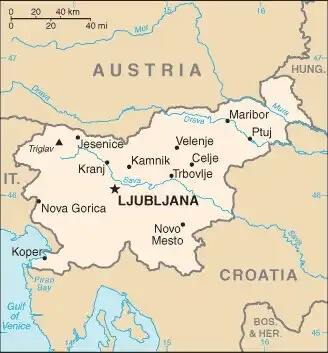World Book
Slovenia
World Book Index
81


With a score of 81, the country is ranked 15th out of 158 countries in the World Book ranking. (more information)
Introduction
Background
In 1918, Slovenia, then part of the Austro-Hungarian Empire, joined the Kingdom of Serbs, Croats, and Slovenes, which was renamed Yugoslavia in 1929. After World War II, Slovenia joined the new Socialist Federal Republic of Yugoslavia. In 1991, Slovenia declared independence after a 10-day war with Serbia. Slovenia joined NATO and the EU in 2004 and the euro zone and the Schengen Area in 2007.
Geography
Area
total : 20,273 sq km
land: 20,151 sq km
water: 122 sq km
Climate
Mediterranean climate on the coast, continental climate with mild to hot summers and cold winters in the plateaus and valleys to the east
Natural resources
lignite, lead, zinc, building stone, hydropower, forests
People and Society
Population
total: 2,097,893 (2024 est.)
Ethnic groups
Slovene 83.1%, Serb 2%, Croat 1.8%, Bosniak 1.1%, other or unspecified 12% (2002 est.)
Languages
Slovene (official) 87.7%, Croatian 2.8%, Serbo-Croatian 1.8%, Bosnian 1.6%, Serbian 1.6%, Hungarian 0.4% (official, only in municipalities where Hungarian nationals reside), Italian 0.2% (official, only in municipalities where Italian nationals reside), other or unspecified 3.9% (2002 est.)
Religions
Catholic 69%, Orthodox 4%, Muslim 3%, Christian 1%, other 3%, atheist 14%, non-believer/agnostic 4%, refused to answer 2% (2019 est.)
Population growth rate
-0.1% (2024 est.)
Government
Government type
parliamentary republic
Capital
name: Ljubljana
Executive branch
chief of state: President Natasa PIRC MUSAR (since 23 December 2022)
head of government: Prime Minister Robert GOLOB (since 1 June 2022)
Diplomatic representation in the US
chief of mission: Ambassador Iztok MIROŠIČ (since 15 September 2023)
Diplomatic representation from the US
chief of mission: Ambassador (vacant); Chargé d’Affaires Brian GREANEY (since August 2025)
Economy
Economic overview
high-income EU and eurozone economy; high per-capita income and low inequality; key exports in automotive and pharmaceuticals; tight labor market with low unemployment; growth supported by private consumption and public investment, with risks from tight labor market and trade conditions; narrowing fiscal deficit and declining public debt
Real GDP (purchasing power parity)
$103.118 billion (2024 est.)
$101.503 billion (2023 est.)
$99.403 billion (2022 est.)
Real GDP per capita
$48,500 (2024 est.)
$47,900 (2023 est.)
$47,100 (2022 est.)
Exports
$59.159 billion (2024 est.)
$57.66 billion (2023 est.)
$56.51 billion (2022 est.)
Exports - partners
Switzerland 22%, Germany 12%, Italy 10%, Croatia 8%, Austria 6% (2023)
Exports - commodities
packaged medicine, cars, refined petroleum, vehicle parts/accessories, plastic products (2023)
Imports
$54.583 billion (2024 est.)
$53.309 billion (2023 est.)
$55.158 billion (2022 est.)
Imports - partners
Switzerland 17%, China 15%, Germany 11%, Italy 9%, Austria 6% (2023)
Imports - commodities
nitrogen compounds, packaged medicine, refined petroleum, cars, vaccines (2023)
Human Development Index
The country's Human Development Index (HDI) is 0.931, ranking it 21st out of 193 countries tested. (more information)
World Happiness Report
The World Happiness Report ranked the country 15th out of 158 countries tested with a score of 6.905. (more information)



